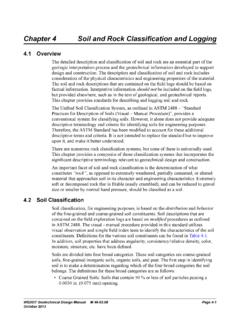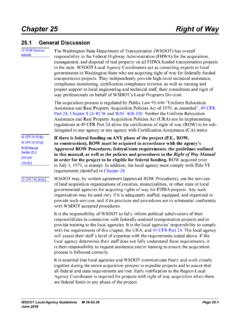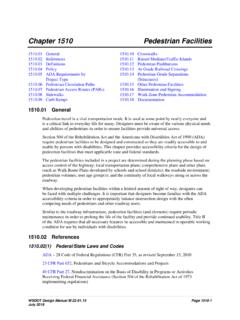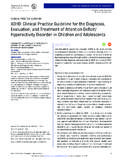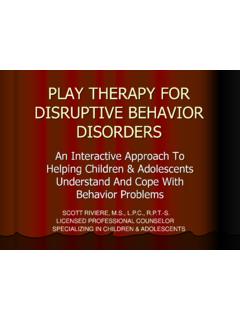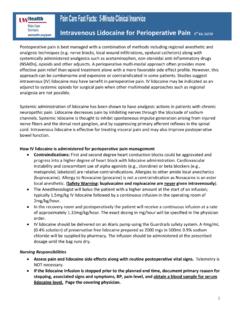Transcription of Chapter 1100 Practical Design
1 WSDOT Design Manual M Page 1100-1 July 2017 Chapter 1100 Practical Design General Practical Design Procedure Community Engagement Advisory Team Need and Performance Identification Context Identification Design Control Selection Alternative Formulation and Evaluation Design Element Selection and Dimensions Documentation Tools References General The Washington State Department of Transportation (WSDOT) is committed to context-appropriate, multimodal , performance-based designs. WSDOT s goal is to optimize existing system capacity and safety through better interconnectivity of all transportation modes. Community engagement is an essential element.
2 This Chapter provides an overview of the Practical Design approach that WSDOT uses to make project decisions. The remaining chapters in Division 11 provide specific Design policy details for each procedural step. WSDOT s Practical Design approach is context-appropriate, multi-modal and performance-based. Practical Design utilizes a collaborative approach, Design flexibility, and a high likelihood of variable solutions. As a result, WSDOT s Practical Design finds consistency through the procedural process applied rather than pre-determined outcomes for projects. This Chapter provides: An overview of the WSDOT Practical Solutions initiative.
3 An overview of the Practical Design process. Information regarding the importance of Design control selection. (1) Practical Solutions Practical Solutions includes Practical solutions planning and Practical Design , as described in Executive Order (EO) E 1090. Practical Solutions enables more flexible and sustainable transportation investment decisions. It encourages this by: (1) increasing the focus on addressing identified performance needs throughout all phases of development, and (2) engaging local partners and stakeholders at the earliest stages of scope definition to account for their input at the right stage of the development process.
4 Practical Solutions includes one or a combination of strategies, including, but not limited to, operational improvements, off-system solutions, transportation demand management, and incremental strategic capital solutions. (1)(a) Practical Solutions Planning Practical Solutions planning is an approach to making planning decisions that considers a variety of conceptual strategies to achieve the desired system performance targets for the lowest cost. Practical Design Chapter 1100 Page 1100-2 WSDOT Design Manual M July 2017 Central to Practical solutions planning is a process that identifies regional and corridor performance areas, engages communities to ascertain local contexts and needs, and applies methods to evaluate and implement short- and long-term solutions.
5 The outcome of Practical solutions planning is a recommended set of multimodal strategies that are cost-effective and balance the goals and objectives of state and local needs. WSDOT s corridor sketch initiative and planning studies inform Practical solutions through the following: Identify performance gaps for a corridor segment, now and in the future. Identify potential strategies to address the gaps. Integrate inputs from partners that support corridor segment performance. Define context and corridor variables. Identify and rank demand management and operational improvements first, then consider capital solutions. Note that Executive Order (EO) E 1090 instructs that the solution may or may not be on a state corridor.
6 (1)(b) Practical Design Practical Design focuses on the specific problem or problems identified during the planning and scoping process. This performance-based approach looks for lower-cost solutions that meet outcomes that WSDOT, collaborating agencies, communities, and stakeholders have identified. Practical Design is a fundamental component to the Vision, Mission, Values, Goals, and Reforms identified in Results WSDOT, the department s Strategic Plan. The primary objectives of the Practical Design approach are: (1) focusing on project need(s), and (2) seeking the most reasonable low-cost solution to meet that need(s). Practical Design allows flexibility and encourages innovation.
7 Practical Design considers incremental solutions to address uncertainties in future scenarios. Practical Design can be applied at all phases of project development; however, it is most effective at the scoping level or earlier, where key decisions are made as to what Design controls and elements are affected by alternatives and how they can best be configured to meet the project objectives. With Practical Design , decision-making focuses on the maximum benefit to the system, rather than the maximum benefit to the project. Practical Design Procedure Practical Design begins when a location under evaluation moves from a discussion of strategies to one of potential solutions within those strategies.
8 The beginning of the Practical Design approach occurs when the scoping phase requires a Basis of Design (BOD), or when the preliminary engineering phase for a funded project initiates. In each of these situations, Practical Design procedures apply whether or not Practical solutions planning has occurred. WSDOT s Practical Design process consists of seven primary procedural steps: 1. Assemble a project advisory team as needed (see ). 2. Clearly identify the baseline need. Define it in terms of performance, contributing factors, and underlying reasons for the baseline need (see Chapter 1101). 3. Identify the land use and transportation context (which includes environmental use and constraints) for the location (see Chapter 1102).
9 Chapter 1100 Practical Design WSDOT Design Manual M Page 1100-3 July 2017 4. Select Design controls compatible with the context (see Chapter 1103). 5. Formulate and evaluate potential alternatives that resolve the baseline need for the selected context and Design controls (see Chapter 1104). 6. Select Design elements that will be included in the alternatives (see Chapter 1105). 7. Determine Design element dimensions consistent with performance needs, context, and Design controls (see Chapter 1106). The Basis of Design (BOD) documents the outcomes of applying these procedural steps. It also serves as a management tool throughout the Design phase, to keep a project team focused on the baseline performance need and agreed performance trade-offs in order to prevent scope creep.
10 During the Design phase, a BOD is required on all projects unless Design elements are not changed (see exceptions in ). During the scoping phase, a BOD is only required as determined by the Capital Program Development and Management (CPDM) Office. See (1) for further information about the BOD. Community Engagement WSDOT has a strategic goal of engaging the community in order to strengthen partnerships, increase credibility, drive priorities, and inform decision-making. Community input informs the project development process from planning to Design . Engaging with the community helps us more fully understand: Performance issues and gaps Context identity Local environmental issues Modal priorities and needs WSDOT encourages recognition of individual community contexts, values, and needs in developing transportation solutions.






